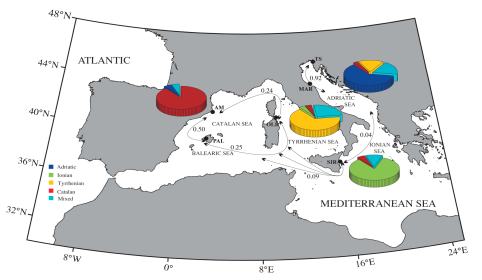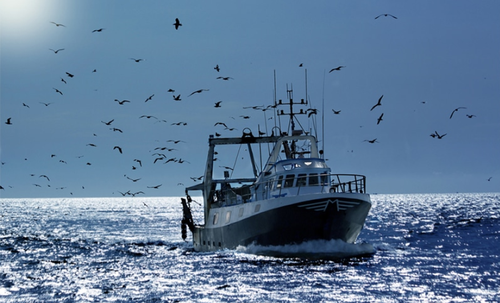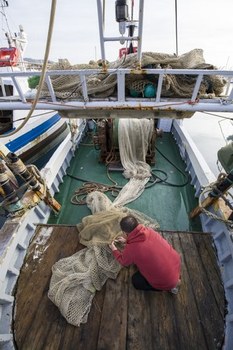Silvia Angelini - Silvia Bianchelli - Samuela Capellacci - Erik Caroselli - Silvia Casabianca - Antonio Dell'Anno - Silvia Franzellitti - Stefano Goffredo - Lisa Locatello - Donata Luiselli - Sarah Magozzi - Arianna Mancuso - Chiara Marchini - Mauro Marini - Antonella Penna - Fiorella Prada - Eugenio Rastelli - Francesco Regoli - Fabio Ricci - Miriam Ruocco - Teresa Sani - Federica Sempucci - Trevor J. Willis

Marine ecology is the study of the interactions between marine organisms and their environment, shedding light on the biological processes involved through biochemical-, cellular-, individual- and community-level observations. It is an interdisciplinary science that combines biology, geology, chemistry, oceanography, geophysics, and statistics. Marine ecosystems are diverse and span from shallow-water ecosystems influenced by sunlight (euphotic zone, up to 150-200 m depth in clear waters), to deep-sea ecosystems where light is minimal (dysphotic zone, up to 1000 m depth) or absent (aphotic zone, beyond 1000 m). Depending on their life traits and position in the water column, marine organisms are classified as pelagic, freely moving within the water column, and benthic, living close to or attached to the seafloor. Among the latter is meiofauna, an assemblage of microscopical animals (500-30 μm) living in the marine sediments all over the world. Twenty-four of the 35 animal phyla have at least one representative within meiofauna, which contribute significantly to the processes and functioning of marine ecosystems thanks to their remarkable abundance and biodiversity, their rapid life cycle, and high metabolic rate. Some meiofaunal taxa have proved to be of significant value for the evaluation of the ecological quality of coastal marine sediments, in accordance with European Directives 2000/60/CE and MSFD 2008/56/CE. Posidonia oceanica meadows and coralligenous assemblages have a particular ecological importance in the Mediterranean Sea, because they are biodiversity hotspots. Posidonia oceanica meadows form dense and extensive beds and provide shelter for a wide variety of marine species. This ecosystem is characterized by high primary production and have a crucial role in the physical equilibrium of a large portion of the Mediterranean coasts, by attenuating waves and currents, reducing sediment resuspension and protecting the beach from erosion. Coralligenous assemblages are structurally complex habitats, built by engineering species that precipitate calcium carbonate structures (e.g., corals, bryozoans, calcareous algae)that have slow growth and low recruitment rates, making this ecosystem particularly vulnerable to environmental disturbance. Both these Mediterranean marine ecosystems are highly threatened by local and global stressors, such as intensive coastal development, pollution, invasive alien species, unsustainable fishing practices, and climate change. In particular, global warming and ocean acidification are among the main threats for marine ecosystems. Assessing the impact of human activities on these ecosystems is a critical step towards planning adequate management and conservation measures of marine natural resources and the ecosystem services they provide to human populations.

In the Mediterranean Sea, sub-regional seas and coastal areas have different hydrographic and climatological regimes. These differences imply different trophic conditions and productivity, as well as the structure and dynamic of phytoplankton communities. In an oligotrophic ecosystem, such as the Mediterranean Sea, coastal productivity largely depends on inputs from rivers, and high-productivity areas are mainly adjacent to river inputs. Coastal ecosystems influenced by anthropogenic nutrient inputs can be affected by hydrographic variability and local conditions that can cause site-specific patterns. While it is known that environmental drivers can select the diversity and functioning of phytoplankton communities, human activities and climate changes are now the new drivers that can significantly determine the functioning of coastal and off-shore ecosystems.

The study of the composition of phytoplankton assemblages and its fluctuations in time and space are of fundamental importance in order to evaluate the human impacts to marine ecosystems. The analysis of the diversity and structure of phytoplankton communities, including HAB species (harmful algal blooms), are carried out through the application of innovative integrated methods based on fingerprinting gene sequences and advanced statistical analyses. The knowledge of the diversity and structure of phytoplankton microorganisms in relation to environmental factors and anthropic pressures is useful for understanding climate changes and/or the alterations taking place on the functioning of the plankton that is the basis of marine food networks. Innovative approaches based on molecular methods (qPCR, metabarcoding, microsatellites, SNPs) are used for the analysis of the genetic diversity of species and structure of phytoplankton populations related to geographical areas, environmental parameters or anthropic pressures.
The study of nutrient dynamics along the coast is carried out in relation to local river and the Po basin inputs with frequent monitoring activities. The time series allow us to understand the role of the Adriatic Sea in relation to anthropic pressures and climate changes through a multidisciplinary study of biogeochemical, hydrological and ecological processes.

Fisheries resources are fundamental components of marine ecosystems. Their abundance is regulated by different variables, such as predation, environmental factors and fishing activity. Stock assessment is the science studying the status of these resources and investigating possible management strategies (Musick and Bonfil, 2005). To reach this aim population dynamic models have been developed in order to estimate the amount of biomass at sea, as well as reference points that allows to evaluate the level of exploitation of these resources. Once the level of exploitation has been defined, it is possible to test different management options in order of addressing the fishery management towards a sustainable exploitation. This science has been developed since the middle of the twentieth century; at the beginning models were quite simply, taking into account only few information, such as landing and effort data. However, the progress of computer science allowed the development of more complex models able of including different type of data, as well as statistical aspects (Quinn, 2003). In more recent years, the need of understanding the effect of fishing activity on the entire ecosystem emerged leading the development of the Ecosystem-Based Fisheries Management (EBFM) approach with the objects of: i) avoid the degradation of the ecosystems, ii) minimize the risk of irreversible changes in the natural species composition and in the ecosystem processes, iii) obtain and maintain long term socio-economic benefits without compromising the ecosystem, iv) develop knowledge on the ecosystem processes able to understand the likely consequences of human actions (Pikitch et al., 2004).
In the Mediterranean area, the stock assessment of the most important commercial species are yearly presented at the General Fisheries Commission for the Mediterranean sea (GFCM - FAO), as well as numerous papers deal with this topic. Numerous studies are also developed in the context of EBFM (es. Coll et al., 2006; Fouzai et al, 2012; Angelini et al., 2016).

Molecular anthropology studies the biological evolution of human populations through the analysis of the DNA. DNA analysis, whether found in ancient human remains or by sampling modern populations, allows to reconstruct past events, also very ancient. In the differentiation of the human populations, environment is a crucial agent, affecting genetic variability through natural selection and causing fast and reversible molecular changes without affecting nucleotide sequences (epigenetic changes) (Giuliani et al., 2015).
The interaction between human populations and sea began at the dawn of humankind evolution, and has lasted until today, through migrations and the effort to access marine resources. In particular, for millennia, the Mediterranean Sea has been an important source of trophic resources, and it tells a story of fishing, navigation systems, and processing and preserving of particular fishery products.
During the evolution of our species, a diet based on aquatic organisms like fish, crustaceans, molluscs, algae, and aquatic plants, not only could has represented a sort of exaptation to the increased nutritional requirements of the brain (Tattersal, 2014), but it has also led to the spread of some genetic variants in some populations. Recent studies show that fishery products can cause epigenetic changes (Hussey et al., 2017; Lau et al., 2019).
Today, fishery products consumption is increasing both in industrialized countries and in the developing world (from 9 to 20.2 kg per capita from 1961 to 2015, FAO, 2018), with European countries bordering the Mediterranean as the major consumer, and with Spain, Italy and France accounting for more than half of European consumption (EUROSTAT, 2014). Nevertheless, also Mediterranean countries, always beneficiaries of the positive effects of Mediterranean diet, from industrial revolution and especially from the second post-war period saw an increased consumption of saturated fatty acids and simple sugar, while decreasing the consumption of essential fatty acids, complex carbohydrates and fiber (Rotilio, 2016). This has influenced the incidence of many chronic disease, including diabetes, cardiovascular disease, obesity and tumor, especially in genetically predisposed populations (Sazzini et al., 2016).
Despite the known beneficial effects of seafood consumption, there are many water pollutants that cause concerns because of their potential effects on the environment and the human health. It is well known how, also when present in small concentration in the environment, a toxin can accumulate in the organism through bioaccumulation, leading to a higher risk of chronic poisoning.
The main interest of our research team is on traditional fishing communities, living along the Italian coasts and with a high content of fish in their diet.Through the molecular analysis it will be possible to reconstruct the demographic history of these populations, and, by means of an accurate collection of questionnaires on family history, life style and diet, video-photographic documentation and climatic data, to understand the complex relationship between genomic background and environment.